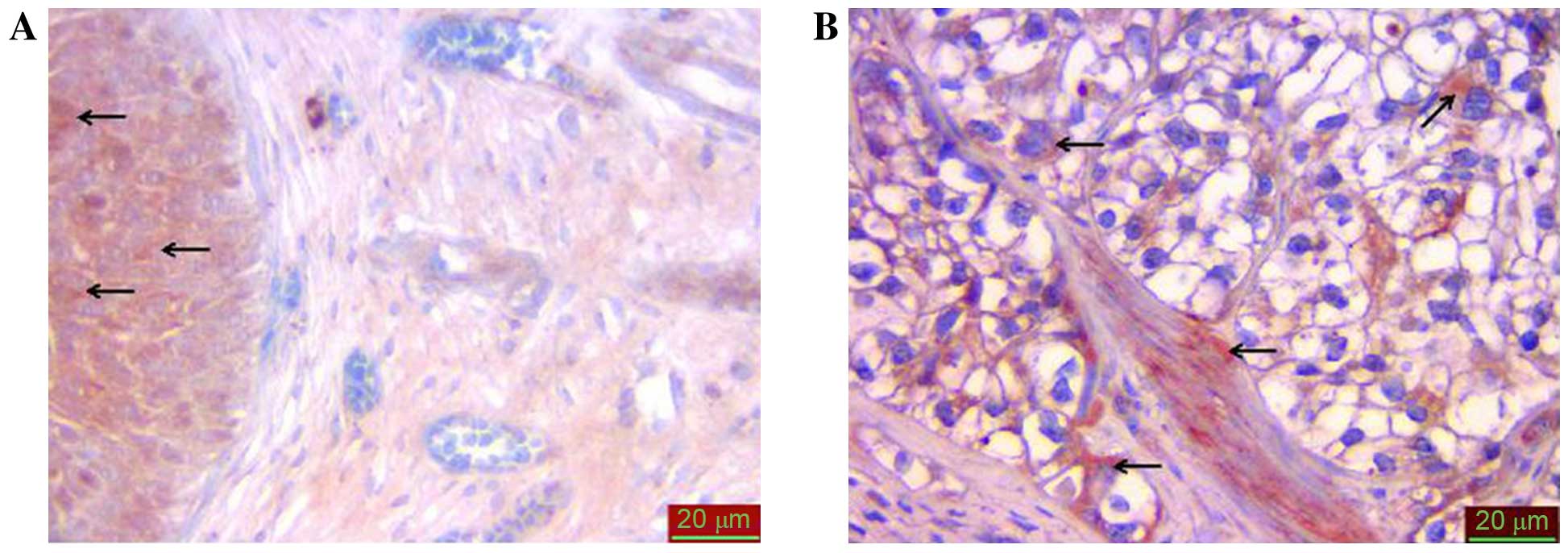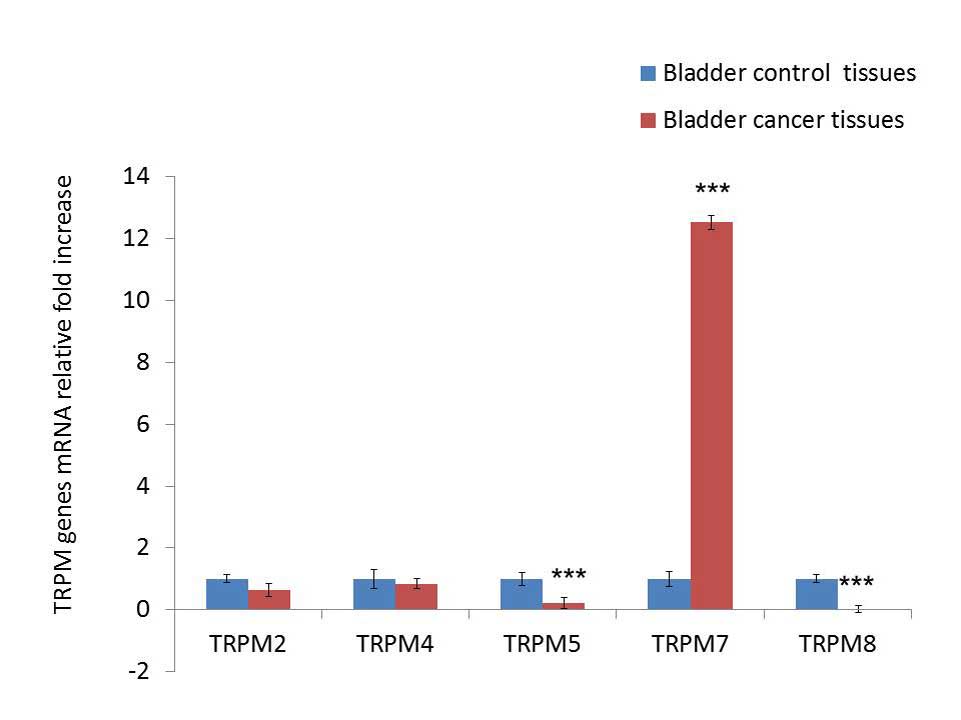|
1
|
Siegel R, Ma J, Zou Z and Jemal A: Cancer
statistics, 2014. CA Cancer J Clin. 64:9–29. 2014. View Article : Google Scholar : PubMed/NCBI
|
|
2
|
Abdel-Haleem AM, El-Zeiry MI, Mahran LG,
Abou-Aisha K, Rady MH, Rohde J, Mostageer M and Spahn-Langguth H:
Expression of RFC/SLC19A1 is associated with tumor type in bladder
cancer patients. PLoS One. 6:e218202011. View Article : Google Scholar : PubMed/NCBI
|
|
3
|
Bukowski RM: Genitourinary oncology:
Current status and future challenges. Front Oncol. 1:322011.
View Article : Google Scholar : PubMed/NCBI
|
|
4
|
Simon F, Varela D and Cabello-Verrugio C:
Oxidative stress-modulated TRPM ion channels in cell dysfunction
and pathological conditions in humans. Cell Signal. 25:1614–1624.
2013. View Article : Google Scholar : PubMed/NCBI
|
|
5
|
Yuen CM and Liu DR: Dissecting protein
structure and function using directed evolution. Nat Methods.
4:995–997. 2007. View Article : Google Scholar : PubMed/NCBI
|
|
6
|
Siegel R, Naishadham D and Jemal A: Cancer
statistics, 2012. CA Cancer J Clin. 62:10–29. 2012. View Article : Google Scholar : PubMed/NCBI
|
|
7
|
Prevarskaya N, Skryma R, Bidaux G,
Flourakis M and Shuba Y: Ion channels in death and differentiation
of prostate cancer cells. Cell Death Differ. 14:1295–1304. 2007.
View Article : Google Scholar : PubMed/NCBI
|
|
8
|
Guinamard R, Sallé L and Simard C: The
non-selective monovalent cationic channels TRPM4 and TRPM5. Adv Exp
Med Biol. 704:147–171. 2011. View Article : Google Scholar : PubMed/NCBI
|
|
9
|
Kraft R and Harteneck C: The mammalian
melastatin-related transient receptor potential cation channels: An
overview. Pflugers Arch. 451:204–211. 2005. View Article : Google Scholar : PubMed/NCBI
|
|
10
|
Everaerts W, Gevaert T, Nilius B and De
Ridder D: On the origin of bladder sensing: Tr(i)ps in urology.
Neurourol Urodyn. 27:264–273. 2008. View Article : Google Scholar : PubMed/NCBI
|
|
11
|
Farooqi AA, Javeed MK, Javed Z, Riaz AM,
Mukhtar S, Minhaj S, Abbas S and Bhatti S: TRPM channels: Same
ballpark, different players, and different rules in immunogenetics.
Immunogenetics. 63:773–787. 2011. View Article : Google Scholar : PubMed/NCBI
|
|
12
|
Xie YF, Macdonald JF and Jackson MF:
TRPM2, calcium and neurodegenerative diseases. Int J Physiol
Pathophysiol Pharmacol. 15:95–103. 2010.
|
|
13
|
Everaerts W, Vriens J, Owsianik G,
Appendino G, Voets T, De Ridder D and Nilius B: Functional
characterization of transient receptor potential channels in mouse
urothelial cells. Am J Physiol Renal Physiol. 298:F692–F701. 2010.
View Article : Google Scholar : PubMed/NCBI
|
|
14
|
Zholos A: Pharmacology of transient
receptor potential melastatin channels in the vasculature. Br J
Pharmacol. 159:1559–1571. 2010. View Article : Google Scholar : PubMed/NCBI
|
|
15
|
Schönherr R: Clinical relevance of ion
channels for diagnosis and therapy of cancer. J Membr Biol.
205:175–184. 2005. View Article : Google Scholar : PubMed/NCBI
|
|
16
|
Mizuno H, Suzuki Y, Watanabe M, Sokabe T,
Yamamoto T, Hattori R, Gotoh M and Tominaga M: Potential role of
transient receptor potential (TRP) channels in bladder cancer
cells. J Physiol Sci. 64:305–314. 2014. View Article : Google Scholar : PubMed/NCBI
|
|
17
|
Guilbert A, Gautier M, Dhennin-Duthille I,
Haren N, Sevestre H and Ouadid-Ahidouch H: Evidence that TRPM7 is
required for breast cancer cell proliferation. Am J Physiol Cell
Physiol. 297:C493–C502. 2009. View Article : Google Scholar : PubMed/NCBI
|
|
18
|
Kim BJ, Park EJ, Lee JH, Jeon JH, Kim SJ
and So I: Suppression of transient receptor potential melastatin 7
channel induces cell death in gastric cancer. Cancer Sci.
99:2502–2509. 2008. View Article : Google Scholar : PubMed/NCBI
|
|
19
|
Zhang L and Barritt GJ: TRPM8 in prostate
cancer cells: A potential diagnostic and prognostic marker with a
secretory function? Endocr Relat Cancer. 13:27–38. 2006. View Article : Google Scholar : PubMed/NCBI
|
|
20
|
Xiao N, Jiang LM, Ge B, Zhang TY, Zhao XK
and Zhou X: Over-expression of TRPM8 is associated with poor
prognosis in urothelial carcinoma of bladder. Tumour Biol.
35:11499–11504. 2014. View Article : Google Scholar : PubMed/NCBI
|
|
21
|
Prevarskaya N, Zhang L and Barritt G: TRP
channels in cancer. Biochim Biophys Acta. 1772:937–946. 2007.
View Article : Google Scholar : PubMed/NCBI
|
|
22
|
Livak KJ and Schmittgen TD: Analysis of
relative gene expression data using real-time quantitative PCR and
the 2(−Delta Delta C(T)) Method. Methods. 25:402–408. 2001.
View Article : Google Scholar : PubMed/NCBI
|
|
23
|
Zhang Y, Zhang D, Li W, Chen J, Peng Y and
Cao W: A novel real-time quantitative PCR method using attached
universal template probe. Nucleic Acids Res. 31:e1232003.
View Article : Google Scholar : PubMed/NCBI
|
|
24
|
Hofmann T, Chubanov V, Gudermann T and
Montell C: TRPM5 is a voltage-modulated and Ca(2+)-activated
monovalent selective cation channel. Curr Biol. 13:1153–1158. 2003.
View Article : Google Scholar : PubMed/NCBI
|
|
25
|
Lazzeri M, Costantini E and Porena M: TRP
family proteins in the lower urinary tract: Translating basic
science into new clinical prospective. TherAdv Urol. 1:33–42. 2009.
View Article : Google Scholar
|
|
26
|
Myers-Irvin JM, Van Le TS and Getzenberg
RH: Mechanistic analysis of the role of BLCA-4 in bladder cancer
pathobiology. Cancer Res. 65:7145–7150. 2005. View Article : Google Scholar : PubMed/NCBI
|
|
27
|
Perraud AL, Schmitz C and Scharenberg AM:
TRPM2 Ca2+ permeable cation channels: From gene to biological
function. Cell Calcium. 33:519–531. 2003. View Article : Google Scholar : PubMed/NCBI
|
|
28
|
Thompson JA, Salcedo E, Restrepo D and
Finger TE: Second-order input to the medial amygdala from olfactory
sensory neurons expressing the transduction channel TRPM5. J Comp
Neurol. 520:1819–1830. 2012. View Article : Google Scholar : PubMed/NCBI
|
|
29
|
Prawitt D, Enklaar T, Klemm G, Gärtner B,
Spangenberg C, Winterpacht A, Higgins M, Pelletier J and Zabel B:
Identification and characterization of mTR1, a novel gene with
homology to melastatic (MLSN1) and the trp gene family located in
the BWS-WT2 critical region on chromosome 11p15.5 and showing
allele-specific expression. Hum Mol Genet. 9:203–216. 2000.
View Article : Google Scholar : PubMed/NCBI
|
|
30
|
Parajuli SP, Hristov KL, Sullivan MN, Xin
W, Smith AC, Earley S, Malysz J and Petkov GV: Control of urinary
bladder smooth muscle excitability by the TRPM4 channel modulator
9-phenanthrol. Channels (Austin). 7:537–540. 2013. View Article : Google Scholar : PubMed/NCBI
|
|
31
|
Smith AC, Parajuli SP, Hristov KL, Cheng
Q, Soder RP, Afeli SA, Earley S, Xin W, Malysz J and Petkov GV:
TRPM4 channel: A new player in urinary bladder smooth muscle
function in rats. Am J Physiol Renal Physiol. 304:F918–F929. 2013.
View Article : Google Scholar : PubMed/NCBI
|
















